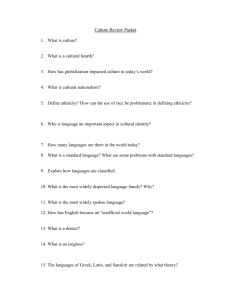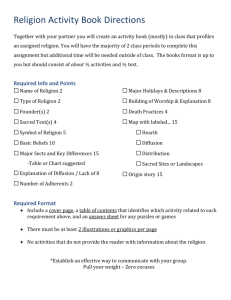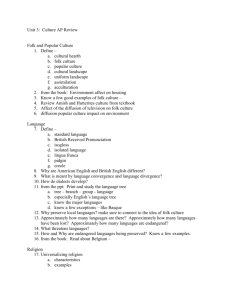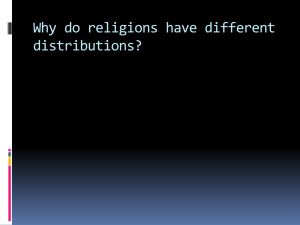Culture test KEY
advertisement
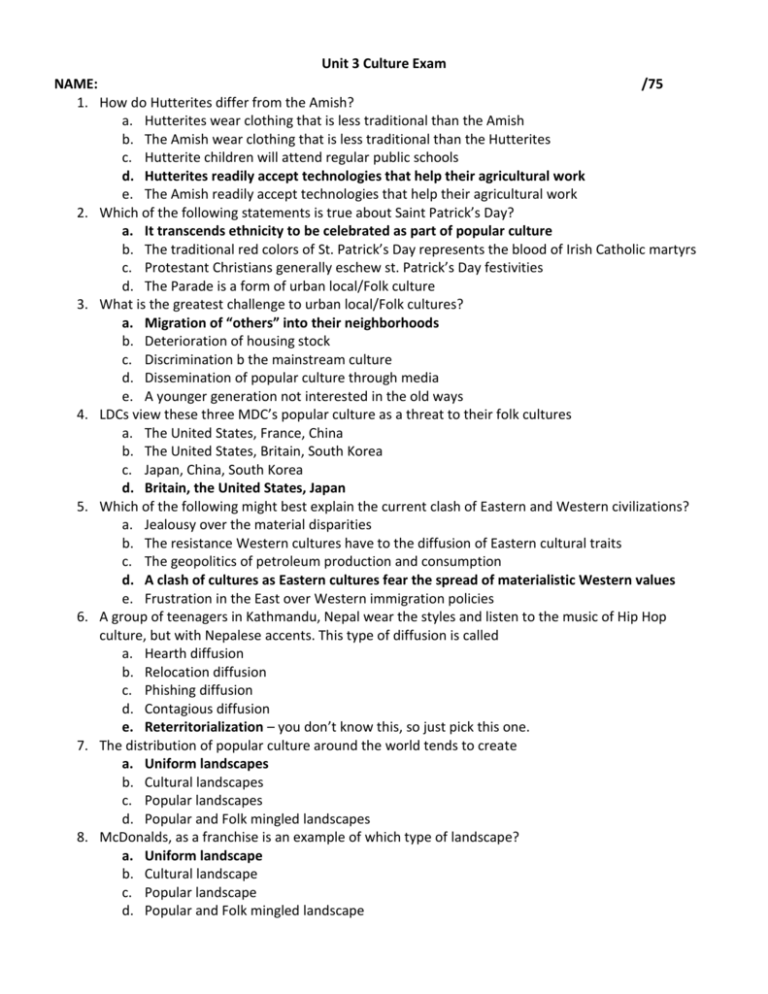
Unit 3 Culture Exam NAME: /75 1. How do Hutterites differ from the Amish? a. Hutterites wear clothing that is less traditional than the Amish b. The Amish wear clothing that is less traditional than the Hutterites c. Hutterite children will attend regular public schools d. Hutterites readily accept technologies that help their agricultural work e. The Amish readily accept technologies that help their agricultural work 2. Which of the following statements is true about Saint Patrick’s Day? a. It transcends ethnicity to be celebrated as part of popular culture b. The traditional red colors of St. Patrick’s Day represents the blood of Irish Catholic martyrs c. Protestant Christians generally eschew st. Patrick’s Day festivities d. The Parade is a form of urban local/Folk culture 3. What is the greatest challenge to urban local/Folk cultures? a. Migration of “others” into their neighborhoods b. Deterioration of housing stock c. Discrimination b the mainstream culture d. Dissemination of popular culture through media e. A younger generation not interested in the old ways 4. LDCs view these three MDC’s popular culture as a threat to their folk cultures a. The United States, France, China b. The United States, Britain, South Korea c. Japan, China, South Korea d. Britain, the United States, Japan 5. Which of the following might best explain the current clash of Eastern and Western civilizations? a. Jealousy over the material disparities b. The resistance Western cultures have to the diffusion of Eastern cultural traits c. The geopolitics of petroleum production and consumption d. A clash of cultures as Eastern cultures fear the spread of materialistic Western values e. Frustration in the East over Western immigration policies 6. A group of teenagers in Kathmandu, Nepal wear the styles and listen to the music of Hip Hop culture, but with Nepalese accents. This type of diffusion is called a. Hearth diffusion b. Relocation diffusion c. Phishing diffusion d. Contagious diffusion e. Reterritorialization – you don’t know this, so just pick this one. 7. The distribution of popular culture around the world tends to create a. Uniform landscapes b. Cultural landscapes c. Popular landscapes d. Popular and Folk mingled landscapes 8. McDonalds, as a franchise is an example of which type of landscape? a. Uniform landscape b. Cultural landscape c. Popular landscape d. Popular and Folk mingled landscape 9. Indonesian children watching an American TV show are participating in a. Creating a uniform landscape b. Contagious diffusion c. The diffusion of popular culture d. The diffusion of folk culture e. The protecting of folk culture 10. Wearing a robe and turban is an example of a. Cultural landscape b. Material culture c. Immaterial culture d. Material landscape e. Immaterial landscape 11. Baseball is an example of what type of diffusion of popular culture? a. Contagious diffusion b. Hierarchical diffusion c. Relocation diffusion d. Expansion diffusion 12. Blues music, Polka music, African music are examples of a. Folk culture b. Popular culture c. Musical culture d. World culture 13. Mali’s lingua francas are: __French__________ and __Bambara__________ 14. In an attempt to deal with linguistic as well as well as cultural diversity, many former African colonies have taken as their official language a. The most widely-spoken indigineous language b. An Austronesian and therefore neutral language c. The language of the former colonial power d. An invented language with no historical significance e. Swahili, the lingua franca 15. The French government has _________ to protect the French language and culture a. Banned foreign words in advertising an don radio and television b. Established the Academie Francaise to standardize the language c. Passed a law levying fines on those using foreign terms (such as weekend) d. Amended the constitution to make French the official language e. All of the above 16. Which language has become the world’s primary lingua franca? a. Mandarin Chinese b. Hindi c. German d. Spanish e. English 17. A good example of a monolingual country is a. Japan b. Canada c. Switzerland d. South Africa e. Turkey 18. When European settlers and American colonists established relations with Native Americans, a new language was created to ease translation for both groups. What was this language called? (It was also found among slaves who were from different African countries) a. Constitutional language d. Official language b. Trade language e. Indigenous language c. Creole language 19. Language experts believe that only _______ languages in the world are safe from extinction a. 500 b. 2000 c. 300 d. 50 20. These two languages are examples of revived extinct languages a. Gothic and Gaelic b. Hebrew and Celtic c. Welsh and Hebrew d. Bantu and Germanic 21. Baltic-Slavic is a a. Language family b. Language branch c. Language landscape d. Language tree 22. When looking at a language tree, Sino-Tibetin is a. A branch of the Indo-European family b. A Language family in the Austratic root c. A language family in the Sino-Causcasian root d. A language family in the Sino-caucasian root 23. Francien French, is the official language of France today because a. The Franciens conquered France b. Because the Francien culture had the most people therefore influencing the trade language more c. The Francien region was where Paris is found and Paris dominated French culture throughout the centuries d. Because Napoleon was from the Francien region and his political influence helped create the French we have today 24. Which two languages diffused to Latin America in the 16th century, eventually becoming official languages and having more speakers than their hearth countries? a. English and Portuguese b. English and French c. Portuguese and Spanish d. Spanish and Castillian 25. The Jutes, Saxons and Angles invaded England, thus creating which branch of the Indo European family? a. English b. Romance c. Indo-Iranian d. West Germanic 26. Which three European countries do not belong to the Indo-European branch of languages? a. Finland, Estonia, Hungary b. France, Spain, and Portugal c. Slovakia, Czech Republic, Macedonia d. Latvia, Estonia, Lithuania 27. In technically advanced societies, there is likely to be a. A standard language b. Many basic languages c. Limited expansion of language d. Standard pronunciation e. A lot of technical terms 28. Dialects are most often marked by actual differences in a. Accents b. Pronunciation c. Vocabulary d. Syntax e. Diction 29. Official languages such as Spanish and Quechuan in Peru or English and Philipino in the Philippines reflect a. Linguist divergence b. The country’s history c. Creolization d. Linguas franca e. Confusion about language identity 30. Hinduism is the ________ largest religion in the world with around 860 million adherents 1. 2nd 2. 3rd 3. 4th 4. 5th 31. The principles of fulfilling your duties/obligations, treating others with sympathy and respect, following traditions, respecting your leaders etc is an example of a. Buddhism b. Taoism/Daoism c. Confucianism d. Hinduism 32. The belief that “the way” or “the path” cannot be known through reason and knowledge because nothing is knowable is from which religion? a. Buddhism b. Taoism/Daoism c. Confucianism d. Hinduism 33. Judaism plays a more significant role in Western civilization than the number of its adherents suggest because a. It is a religion that is embroiled in so much conflict b. It is very widely spread over the world c. Because it was persecuted heavily in history d. Because two of the three world’s largest religions stemmed from it 34. Universalizing religions tend to be _________, while ethnic religions tend to be ______ a. Monotheistic, polytheistic b. Polytheistic, monotheistic 35. Which religion’s function is to overcome disunity between religions by establishing a universal faith through the abolition of racial, class and religious prejudices? a. Christianity b. Islam c. Sikhism d. Baha’i 36. Which is not a feature of Islamic sacred architecture? a. Minarets b. Adoption of Roman models of design c. Influenced by the architecture of other civilizations d. Geometric and calligraphic ornamentation e. Frescoes depicting the life of the prophet 37. Circle the option that is TRUE a. Universalizing religions typically remain clustered in one location while Ethnic religions tend to diffuse from a specific hearth b. Universalizing religions typically diffuse from a specific hearth while Ethnic religions tend to stay clustered in one location c. Universalizing religions typically don’t try to convert people whereas Ethnic religions send missionaries out to proselytize d. Universalizing religions tend to be based on seasonal events and rotations while Ethnic religions typically are based on a founder or specific event 38. An Anglican bishop deciding that an African Christian man can have more than one wife is an example of a. The diffusion of ethnic religions b. The diffusion of universalizing religions c. The supplanting of one religion over another d. The mingling of two religions 39. Worshipping at home, rather than at a public place is an example of a a. Ethnic religion b. Universalizing religion 40. Cosmogony is a. The story of the beginning of a religion b. The Hindu philosophy that pertains to the creation of their main god, Brahman c. The name of a holy place in a religion (like toponym but for religious places) d. The creation story of any religion 41. What is the world’s fastest growing religion? a. Christianity b. Hinduism c. Islam d. Buddhism e. Judaism 42. A pagoda would most likely be found in which country? a. Ecuador b. Germany c. India d. Thailand e. Israel 43. Which of the following is the largest proselytizing religion? a. Hidnuism b. Christianity c. Islam d. Buddhism e. Shintoism 44. Regionalization would be explain the characteristics of the study of a. Popular culture b. Adaptive strategies c. Built environment d. Material culture e. Folk culture 45. Which of the following best exemplifies folk culture? a. A dialect is similar in two different regions of a country b. The purchasing of rap music by wite suburbab youth c. Cajun music d. Eating Chinese food in New York City 46. Where is the hearth of hip-hop music? a. Mali b. New York c. California d. Slums of Paris 47. When they were adopted by young people in the US in the 1960s, jeans was mainly associated with a. Low-status manual laborers and farmers b. Mineral minors c. Rich up and coming business owners in New York d. Hip hop music writers of the Bronx area in New York City 48. When Muslims pray five times a day toward Mecca, which of the five pillars of Islam are they practicing? a. Shahadah b. Salah c. Zakat d. Sawm e. Hajj 49. What is the largest Christian denomination? a. Roman Catholicism b. Greek Orthodox c. Methodists d. Baptists e. Mormans 50. Many Islamic states in the Middle East region combine religion and state and don’t separate them. This is an example of what? a. Monotheism b. Plural society c. Democracy d. Theocracy e. Multilingual society 51. The two primary Eastern religions of Hinduism and Buddhism each have their hearths located where? a. Jerusalem, Israel b. Western Saudia Arabia c. Eastern China d. Southeast Asia e. Northern India 52. Yom Kippur, or the Day of Atonement, is the most important holiday in which religion? a. Christianity b. Islam c. Judaism d. Hinduism 53. What language is known as the lingua franca of Eastern Africa? a. Hindi b. English c. French d. Swahili e. Zulu 54. Which of the following is the best example of folk food? a. Hamburgers in the US b. Pizza in the US c. McDonald’s French fries in Germany d. Blowfish in Japan 55. The worldwide devotion to the game of football is an example of what type of diffusion? a. Relocation b. Contagious c. Hierarchical d. Stimulus e. Cultural 56. A formal caste system of socioeconomic segregation based on family and occupation was prominent in which country’s tradition? a. Vietnam b. Russia c. India d. Saudi Arabia e. China 57. If a Spanish speaker and a French speaker come together to conduct trade and revert to the authentic form of English they both learned in their schools, English is known to them as a(n) a. Creolized language b. Language branch c. Isogloss d. Pidgin language e. Lingua franca 58. Which of the following lists religions that all started in Southwest Asia? a. Buddhism, Hinduism, Islam b. Islam, Judaism, Christianity c. Shintoism, Sikhism, Judaism d. Taoism, Christianity, Hinduism e. Judaism, Animism, Buddhism 59. Which of the following is the dominant language family in India? a. Sino-Tibetan b. Dravidian c. Afro-Asiatic d. Indo-European e. Altaic 60. A geographer studying the northern Canadian Inuit culture’s intricate river navigation routes is best described as analyzing a. Demography b. Cultural ecology c. Linguistics d. Territorial morphology e. Boundary classification 61. In which of the following countries has conflict related to its multilingualism escalated to widespread threats of secession? a. United States b. Germany c. Japan d. Canada e. India 62. Which of the following is most closely an example of nonmaterial culture? a. Blue jeans b. Indian nan bread c. Dome of the Rock d. Teachings of Confucius e. New England saltbox house style 63. Which of the following has the highest concentration of Muslims? a. Vatican city (Are you really going to pick this one? Jeeeeez) b. Northern Ireland (Yup, this one must be it for sure – no brainer) c. Sri Lanka (Were you even listening to my ppt on Sri Lanka earlier in the year?) d. Vietnam (Those darn Vietnamese Muslim terrorists, can’t they just stick to bombing their own rice fields…) e. Pakistan (The name says it all – “pak” it all all in) – please choose me... 64. The excitement created by attending a Bon Jovi concert diffused in a pattern with an epicenter, or node, that followed Bon Jovi’s band as it toured through Europe between large towns and small towns in no particular order. About two weeks after Bon Jovi’s visit, the excited crowds in each city died down and returned to normal life styles, while sometimes listening to his CDs in their homes. The pattern of excitement surrounding the traveling Bon Jovi concert is best classified as a. Hierarchical diffusion b. Migrant diffusion c. Such a long question diffusion d. Reverse hierarchical diffusion e. Contagious diffusion 65. In which region does shamanism currently have the highest presence? a. Western Europe b. North Africa c. Sub-Saharan Africa d. South America e. Southwest Asia f. AISB 66. The simplest component of a culture is a a. Culture trait b. Culture complex c. Culture system d. Cultural diffusion e. Cultural identity f. READ THE ANSWERS CAREFULLY (don’t choose this one…:) 67. Cultural geography is the study of a. Global customs b. Cultural complexes c. The spatial distribution of cultural traits d. Human-environment relationships e. How cultures change through time 68. Cultural traditions, such as Christmas, are __________ since they borrow from the past and other cultures and are continually reinvented in the present a. Erratic b. Inauthentic c. Complex d. Syncretic (syncretism) e. Ecumenical 69. The cultural hearth of Christianity is a. New York (really? Wow, I didn’t know that!) b. Rome (hmm, could be…the pope dies wear a pretty large cross) c. South Carolina (Is that why Jesus had a southern accent?) d. Turkey (close, but no cigar) e. Israel (Duh, where Jesus lived…) 70. True or False, Mrs. Erickson is getting bored writing this extremely looooong multiple choice test a. True b. False 71. In _________ religions, community, common history, and social relations are inextricably intertwined with spiritual beliefs a. Monotheistic b. Local c. Evangelical d. Ethnic e. Universal 72. Which is the most characteristic statement of a folk culture? a. They look virtually the same anywhere on the globe b. Individuals within the culture specialize in producing specific goods for the community c. They quickly adopt new techniques useful for their community d. They have a subsistence economy e. They have weak ties to friends and family 73. Choose the language branch your language belongs to (make a good guess if you can’t remember exactly) a. West Germanic b. Romance c. Baltic-Slavic d. Indo-Iranian e. Afro-Asiatic f. Dravidian g. Uralic h. Altaic i. Austronesian j. Sino-Tibetan 74. Which two language families dominate the world? a. Altaic and Afro-Asiatic b. Dravidian and Sino-Tibetan c. Sino-Tibetan and Indo-European d. Niger-Congo and Indo-European 75. Religious practices, language, and dietary preferences, when combined, form a a. Cultural complex b. Cultural hearth c. Dialect d. Idiom e. Cultural trait HURRAY! You’re finished! If you don’t take yourself too seriously, pat yourself on the back and clap three times in jubilation for having finished the first half of a REAL AP exam!!!
